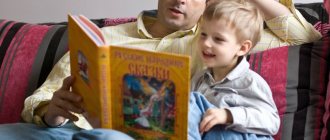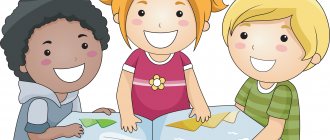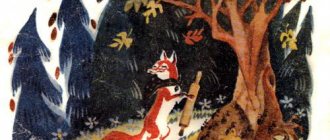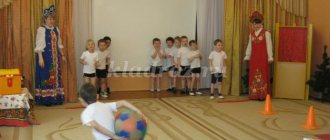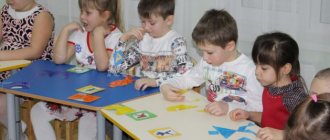The role of fairy tales in the formation of moral qualities of a child
A fairy tale plays a very important role in the formation of a child’s moral qualities. And from the very beginning it is necessary to pay attention to the gender approach of the fairy tale. As for gender, all fairy tales contribute to the formation of male and female character traits.
Fairy tales for the formation of human character traits are, for example, “The Three Little Pigs”, “Kolobok”. They show the method of fighting for a person. The fairy tale “The Three Little Pigs” gives a successful scenario for defeating a superior opponent, and the fairy tale “Kolobok” contains the most important warning about the conditions under which you can be defeated and about observing safety rules. Based on these stories, the typology of the enemy and the scenarios for fighting and defeating the enemy can be explained to the boy. In a confrontation with one opponent you need strength, with another - caution and prudence, with a third - a reliable team, with a fourth - a tactical conversation. Stories that have a masculine character contain three important ideas for a boy: firstly, the correct perception of reality, secondly, the concept of the enemy and security, and thirdly, the desire to defeat the enemy. They symbolically give the boy knowledge about the strategy and tactics of fighting the enemy. Strong cover, combined forces, luck, knowledge and exploitation of one's own advantage and the enemy's weaknesses are the ingredients for success. Everything a boy remembers as a child shapes his adult life. Russian folk tales form in future men such qualities as the ability to withstand difficulties, courage, bravery, immortality before the enemy, respect and love for mother (wife).
But fairy tales - “Masha and the Bear”, “Khavroshka”, “Morozko”, “Goose Swans” help to form female character traits. These tales necessarily have a male character. The heroine builds relationships with him in different ways. She either gets involved in an argument, prepares for a happy marriage, or helps him. These tales help a girl understand what it means to be a woman. In these fairy tales, the girl receives certain knowledge about the life of the heroines. The first is to find a worthy partner, that is, choose the best. And the choice is associated with the ability to listen to your heart, which will say: who is worthy, loving, faithful, always ready to help. Accept the help with gratitude, and what you do will come true. Secondly - to create a comfortable environment where she feels calm and protected, where her strength is multiplied to understand and give love, where she can raise children - the continuation of the race. Love and tolerance are the main manifestations of femininity in Russian culture.
But there are stories through which we can develop moral qualities in both boys and girls. They have the same ending and always end with the reunion of the hero and heroine - a wedding. Thus, fairy tales are an effective means of developing personal moral qualities and national character traits.
What kind of our children will be - attentive, caring, kind, compliant, sweet or, conversely, selfish, tactless, aggressive - depends only on us - their parents? In the family, children form their attitude to the world of people, to things, to nature, develop and strengthen their feelings.
How can we raise our children to be kind, empathetic, and considerate people? How to raise a child so that he grows up to be a happy person?
Moral feelings of preschoolers are formed in combination with moral behavior. Be sure to talk to your child after reading the story. During this time, you can reveal the essence of the characters, evaluate their actions, talk about the positive and negative aspects. The choice to read stories aloud depends on what kind of moral feelings you can develop in your child.
Developing a sense of respect for elders is organically connected with the task of creating a culture of behavior in children towards other people. The habit of always being polite, the willingness to actively take care of the older and younger generations, the results of the work of adults in caring for their activities. Linguistic culture and moral values (truthfulness, honesty, modesty, patience, tolerance and conformity) continue to evolve.
Consultation for parents “Fairy tale as a means of spiritual and moral education of preschool children”
Shevela Oksana Vadimovna
Consultation for parents “Fairy tale as a means of spiritual and moral education of preschool children”
Consultation for parents
“ Fairy tale as a means of spiritual and moral education for preschoolers
ov"
Through a fairy tale , fantasy, play, through unique children's creativity - the right path to a child's heart. A fairy tale , a fantasy, is the key with which you can open these origins and they will fill with life-giving keys. ”
V. A. Sukhomlinsky
Moral education is the most important aspect of raising a child ; it contributes to the enrichment of spiritual experience , the emotional sphere of the individual, affects the knowledge of social reality, and increases the cognitive activity of preschoolers . One of the means of creating positive moral ideas in children and establishing closer contacts between adults and children in the family and in kindergarten is a fairy tale . It is known that the fairy tale is the oldest genre of folk art. It teaches a person to live, instills in him optimism, faith in the triumph of goodness and justice. Behind the fantastic nature fairy-tale plots and fiction, real human relationships are hidden. This is where fairy-tale fantasy .
The great Russian teacher K. D. Ushinsky assigned a major role to the fairy tale He argued that the pedagogical value of folk art cannot be replaced by any stories . The fairy tale is close and understandable to child psychology. There is always a lesson in the content of . The tale does not give direct instructions. There is always good and evil, positive and negative heroes.
Fairy tales develop positive qualities: kindness, mercy, empathy, honesty, hard work. At the same time, they condemn: greed, anger, laziness, cowardice, etc. With the help of fairy tales the child learns to distinguish good from evil, good from bad. Folklore reflects the moral principles and traditional values of society. In the process of working with a fairy tale, children comprehend the basics of the spiritual culture of their people. At each age stage, more complex moral concepts are acquired. Enriching the content of speech and the correct choice of speech means determine the effectiveness of the educational process .
The educational possibilities of fairy tales at the formation of moral ideas in preschool age . At a young age, it is necessary to teach children to listen to fairy tales , follow the development of the action in it, and empathize with the heroes of the work. It is important to explain to children the actions of the characters and the consequences of these actions, to repeat the most interesting, expressive passages and to give children the opportunity to finish words and phrases that are easy to reproduce . Children early learn to correctly assess the size of phenomena, deeds and actions and understand the funny side of all life's inconsistencies. The cheerful and perky bun is so confident in himself that he himself did not notice how he became a braggart, flattered by his own luck - so he was caught by the fox ( "Kolobok"
).
It is advisable to form such moral categories as good and evil, good and bad, possible and impossible, by your own example, as well as with the help of fairy tales , including those about animals. These tales help to show how the kind and peace-loving ones win ( “The Wolf and the Seven Little Goats”
);
For example, the fairy tale “Turnip”
teaches younger
preschoolers to be friendly and hardworking; the fairy tale “Masha and the Bear”
warns: you can’t go into the forest alone - you can get into trouble, and if this happens, don’t despair, try to find a way out of a difficult situation;
fairy tales “Teremok”
,
“Winter Quarters of Animals”
teach how to be friends.
The order to obey parents and elders is heard in the fairy tales “Geese and Swans”
,
“Sister Alyonushka and Brother Ivanushka”
,
“Snow Maiden”
,
“Tereshechka”
.
Fear and cowardice are ridiculed in the fairy tale “Fear Has Big Eyes
,” and cunning in
the fairy tales “The Fox and the Crane
,
“The Fox and the Black Grouse
,
“The Little Fox and the Gray Wolf,”
etc.
Hard work in folk tales is always rewarded ( “Khavroshechka”
,
“Moroz Ivanovich”
,
“The Frog Princess”
, wisdom is praised (
“The Man and the Bear”
,
“How a Man Divided Geese”
,
“The Fox and the Goat”
, caring for loved ones is encouraged (
“ Bean Seed "
). Our task is to teach how to evaluate the actions of
fairy-tale heroes , to give the opportunity to be in the role of a character, to act, to feel the emotions that accompany the actions of the hero.
Stages of working with a fairy tale :
• Introducing children to Russian folk tales - reading , storytelling , conversations on the content, looking at illustrations - in order to develop an emotional attitude towards the actions and characters of the fairy tale .
• Emotional perception of fairy tales by children - children's retelling of the content of the fairy tale , table theater, outdoor games with characters from fairy tales - in order to consolidate the content of fairy tales . These forms of working on a fairy tale allow you to find out how children understood the essence of the fairy tale .
• Artistic activities - attitude towards the hero of a fairy tale in modeling , drawing, appliqué, design - allow children to express their attitude towards the heroes of a fairy tale , embody their experiences, develop skills of empathy, sympathy for the fate and actions of the heroes of a fairy tale .
• Preparation for independent activities - acting out scenes from fairy tales , theatrical games, dramatization of fairy tales , creative play using characters, plots from fairy tales - the method of turning children into heroes of fairy tales contributes not only to the development of sympathy, but also to understanding the moral lessons of fairy tales , the ability to evaluate actions not only the heroes of the fairy tale , but also the people around them.
It is best to read a story before bedtime , when the child is calm, in a good mood and ready to listen carefully. You need to read it emotionally. At the end, you can discuss the fairy tale : what you liked and what you didn’t. Ask your child to describe the characters.
Tell the story in an interesting way , as if feeling that this is a different world. Read with good diction and intonation, then the child will learn to pronounce sounds clearly.
A child's personality begins in childhood. Therefore, the sooner literature, namely a fairy tale , touches the strings of a child’s soul, and not just the mind, the more guarantees there are that good feelings will prevail in them over evil ones. After all, literature is a pounding heart that speaks in the language of feelings.
Pedagogical value of Russian fairy tales
The educational value of fairy tales lies in the fact that they capture the best qualities of the Russian working people: Love for freedom, natural intelligence, perseverance, perseverance.
Fairy tales teach children to be proud of their people and love their Motherland. A folk tale usually evokes rich emotions in children, which enhances its educational effect. The intensity of children's experiences is closely related to the content of the plot, the variety of adventures experienced by its characters.
Emotions help preschoolers understand the meaning, the main idea of the work. These qualities of a folk tale characterize it as a highly artistic work for children, which corresponds to the psychological characteristics of the age. The fairy tale speaks to children in the language of art - light, cheerful, understandable and convincing. A fairy tale is not just a fantasy for a child, it is a special reality, the reality of the emotional world. A fairy tale expands the framework of ordinary life for a child; only in a fairy tale form do preschoolers encounter such complex phenomena and feelings as life and death, love and independence, anger and pity, betrayal and cunning, and the like.
The form of presentation of these phenomena, special, fairy-tale, understandable to a child, and the level of manifestations, moral meaning remain real “adults”. These lessons that the fairy tale gives are lessons for life for both young and old. These are unprecedented moral lessons for children that show how fairy tales affect children in ways that adults cannot foresee [1].
Listening to fairy tales, children deeply sympathize with the characters, they have an internal impulse to help, help, protect, but these emotions quickly disappear because there are no conditions for their realization. True, they are like a battery that charges the soul with moral energy. When you read fairy tales to a child, when you look at the pictures with him and comment on them with sincere interest, you understand that this is perhaps more important and, above all, more effective than subsequent work with adult children for several years. This is what creates that wealth - a natural and constant interest in books, in the idea of a correct, beautiful literary language, a taste for the native language, which will later be called innate literacy. Skip this point, and it will take years of special techniques and other pedagogical wisdom to achieve what is now so easily achieved - just read fairy tales to your child.
Fantastic tales filled with wonder and magic always attract children. The child happily immerses himself in the unreal world, actively acts in it, and creatively rearranges it. But this unreal world seems only to us, adults. The child perceives everything that happens in a fairy tale as reality. This is what his inner world requires.
Transforming into fairy-tale heroes, princes and princesses, witches and fairies, children complete tasks much more enthusiastically and joyfully than just Petya, Misha, Galya, Tanya.
Features of the fairy tale as a genre
In order to most effectively use a fairy tale to develop moral qualities in children, you need to know the features of a fairy tale as a genre.
Many fairy tales inspire confidence in the triumph of truth, in the victory of good over evil. Children especially love the optimism of fairy tales and enhance the educational value of these means.
The intensity of the plot, imagery and entertaining nature make fairy tales an effective teaching tool. The pattern of events, external clashes and struggles in fairy tales is very complex. This circumstance makes the plot fascinating and attracts the attention of children to it. Therefore, it is legitimate to assert that fairy tales take into account the mental characteristics of children, especially the instability and mobility of their attention.
Imagery is an important feature of fairy tales, which facilitates their perception by children who are not yet capable of abstract thinking. The main character traits that bring him closer to the national character of the people: Courage, hard work, wit, etc., as a rule, are very clearly expressed in the hero. These qualities are manifested both in events and through various artistic techniques, such as hyperbolization.
The images are complemented by funny narratives. As wise educators, people paid special attention to the fact that fairy tales are fascinating. Usually they contain not only bright and lively images, but also humor. The listener is often amused by fairy tales of all nations. An example of such tales is the fable of the werewolf.
Didactics is one of the most important features of fairy tales. Consequences are used to reinforce didactics. “Doing good” is taught not through general argumentation and teaching, but through vivid images and convincing actions. This or that instructive experience gradually accumulates in the consciousness of the listener.
Working with fairy tales takes various forms: Reading fairy tales, retelling them, discussing the behavior of fairy-tale characters and the reasons for their successes or failures, theatrical performances of fairy tales, holding a competition for storytellers, exhibitions of children's drawings based on fairy tales, and much more.
When a child begins to recognize himself and explore the world around him, he has many questions for adults. Many questions from children confuse adults. It is not easy to explain to a child why things happen the way they happen, and what is “good” and what is “bad.”
One of the hallmarks of a true fairy tale is a good ending. This gives the child a feeling of psychological security. Whatever happens in a fairy tale, everything ends well. It turns out that all the trials that the heroes faced were necessary in order to make them stronger and wiser. On the other hand, the child sees that a hero who has done something bad will definitely get what he deserves. And the hero who has passed all the tests and shown his best qualities will certainly be rewarded. This is the law of life: how you treat the world, it treats you!
A fairy tale enters a child's life from an early age, accompanies him throughout preschool age and remains with him throughout his life. Fairy tales are the beginning of a child’s acquaintance with the world of literature, human relationships and the world in general.
Fairy tales give children poetic and nuanced portrayals of their characters and leave room for imagination. Moral concepts, vividly depicted in the images of heroes, are reinforced in real life and in relationships with loved ones, becoming moral standards that determine the desires and actions of the child.
The fairy tale, its composition, the vivid opposition of good and evil, fantastic and morally unambiguous characters, expressive language, the dynamics of events, special cause-and-effect relationships and phenomena understandable to preschoolers make the fairy tale especially interesting and fascinating for children, an indispensable tool for the formation of a morally healthy personality in children .
ARTICLE “Moral education of children of senior preschool age through fairy tales” article
MORAL EDUCATION OF SENIOR PRESCHOOL CHILDREN THROUGH FAIRY TALES
E.N. Bartuli, teacher
MADOOU No. 3, Severouralsk
“A fairy tale develops the child’s inner strengths, thanks to which a person cannot help but do good, i.e. teaches empathy"
V.A. Sukhomlinsky
Currently, we are increasingly seeing examples of children’s cruelty and aggressiveness towards each other, towards loved ones. Under the influence of far from moral cartoons, children have distorted ideas about moral qualities: kindness, mercy, justice. From birth, a child is aimed at the ideal of good, so from early preschool age it is necessary to show the child the moral essence of every action. [1]
Observing children in the older group, they noted that not all children know how to communicate with each other; some show a tendency towards hostility, reluctance to share toys and help a friend in a difficult situation. Children have poorly developed skills of sympathy and empathy.
To solve this problem, a lot of literature has been studied. We liked the fairytale therapy method. A fairy tale enters a child’s life from a very early age, accompanies him throughout preschool childhood and remains with him for life. His acquaintance with the world of literature, with the world of human relationships and with the entire surrounding world in general begins with a fairy tale. Moral concepts, vividly represented in the images of heroes, are reinforced in real life and relationships with loved ones, turning into moral standards that regulate the desires and actions of the child. [3]
While studying methodological literature, we came across a book by Shorygina T.A. "Good Tales" This manual presents fairy tales and poems dedicated to such human feelings and qualities as love, friendship, loyalty, mercy, compassion, etc. [6]
It was assumed that if we engage in the formation of moral education in children of senior preschool age through fairy tales, then we will develop moral qualities in children. Based on the hypothesis put forward, we developed the project ““A fairy tale is a lie, but there is a hint in it, a lesson for good fellows.” The purpose of which was: Moral education of children of senior preschool age through fairy tales.
Then we drew up a thematic plan and distributed it by month. October - “What is kindness”, November - “What is hospitality”, December - “What is mercy”, January - “What is truth and lies”, February - “What is fidelity”, March - “What is love and affection” ", April - "What is indifference and responsiveness", May - "What is patience and tolerance", June - "What is good and what is bad." The project turned out to be long-term. We also drew up a plan for interaction with parents and society.
When interacting with children, the most common method of introducing a fairy tale is reading by the teacher, i.e. verbatim transmission of the text. Handling a book with care while reading is an example for children. After reading the fairy tale, we consider the use of conversation with elements of discussion, story, and example to be an important method in implementing the project. When talking with children, they encouraged them to think and talk. Children learned to fairly evaluate the actions of fairy tale heroes and their peers, and learned to understand what is good and what is bad. [2]
After discussing what they had read, they included the children in various types of children's activities. For example, the children drew based on fairy tales, short stories, poems, or composed a fairy tale or a life story. Children's works were compiled into albums of children's creativity.
The activities also resulted in: entertainment, concerts, promotions, theatrical performances, photo collages.
The “Journey to the Land of Kindness” and “Russian Hospitality” entertainment, which we organized for children, is a good basis for learning. On the one hand, they consolidate the skills and abilities acquired in the classroom, and on the other hand, in an interesting way they evoke the need to learn new things, broaden their horizons and knowledge about the world around them.
During the project, the guys and I showed concerts with the goal of doing something good, bringing joy, and providing care and attention to the people around us. A memorable concert was for orphans at the Children's Home. The children were worried about their performance, but in the end they were very pleased. At the end of our meeting, the kids also gave us small souvenirs. For a long time, the guys still remembered our charity event.
In theatrical productions or when watching them, a child not only receives information about the world around him, the laws of society, the beauty of human relationships, but also learns to live in this world, build relationships with others, and this, in turn, requires creative activity of the individual, the ability to behave in society. So, our children have prepared several fairy tales for kids - these are “Bag of Fairy Tales”, “Zayushkina’s Hut”, “Fly-Tsokotukha”.
Helping children is another form of moral education. The children helped the kids not only get dressed for the street, but also took them on sled rides and sealed the books.
Participation in the following campaigns: “Action to Help Homeless Animals”, “Action “Make a Feeder and Feed the Birds” creates in children a sense of responsibility and sympathy for our smaller brothers. During the campaign to help homeless animals, children brought food, dishes, and fabric, which were handed over to representatives of the shelter during the meeting; made propaganda leaflets. In the “Make a Feeder and Feed the Birds” campaign, children together with their parents made feeders and brought food to the birds.
They made collages. Thanks to this work, children learn to work in a team, they develop creative imagination, cohesion, and most importantly, love and respect for the people around them.
During the implementation of this project, the following conclusions can be drawn. As a result of joint activities (teachers, parents, society and children), children had the opportunity to expand their horizons about fairy tales and their heroes, learned to empathize with the heroes, and learned moral standards of behavior. And most importantly, they began to develop a cognitive interest in fairy tales and their author. The children had a desire not only to read, but also to retell and dramatize.
Children acquired: Sustained interest in fairy tales. Moral standards of relationships and behavior. The desire to dramatize fairy tales and include them in your work. A rich baggage of fairy tales.
Children learned to: Recognize fairy tales. Retell fairy tales. Answer questions about the content of fairy tales. Evaluate the actions of heroes and imitate positive characters. Reflect your feelings about fairy tales in productive activities. Treat books with care.
Family, kindergarten and society play an important role in the process of moral development of the individual in the early stages. Parents are the first main teachers. But now is a “difficult” time. Many people are strongly influenced by the ideas of materialism, their ideas about the world are distorted, personal gain becomes higher than morality and honesty, and this has a detrimental effect on their spiritual development. [5] In order to establish contacts with the family to ensure unity in the education of moral culture, the following forms of work were used: meetings, consultations, moving folders, memos, individual conversations, joint activities with children
During the implementation of the project, the number of parents who consider it necessary to carry out work on the moral education of preschoolers in preschool educational institutions has increased; managed to overcome the standard view of parents on their role in kindergarten - the role of a passive consumer of educational services. They developed an interest in the educational process, the development of creativity, knowledge and skills in children, a desire to communicate with the teacher, and to participate in the life of the group. Moms and dads provided active assistance in organizing excursions and watching educational cartoons. They also provided great support to the development of children's creativity. Parents and children did homework of a creative nature (inventing riddles; designing a book of fairy tales, selecting illustrations for fairy tales, constructing fairy tales from paper and natural materials.
Library staff provided us with great support in implementing the project. The guys and I visited the library every month, where they conducted a program for us on a certain topic in accordance with the plan.
Working in close cooperation with the library, we concluded that it is joint, systematic work on moral education that allows children to develop such feelings and qualities as love for their parents and their family, respect for elders, love and interest in the Motherland, and a desire to help people , which creates the foundation for the formation of moral qualities in the future and prevents the child from accumulating negative experiences and prevents the development of unwanted skills and behavioral habits.
Assessing the developing subject-spatial environment, it can be noted that it has been replenished with books, albums, folders with stories and drawings of children.
So, the implementation of the project “A fairy tale is a lie, but there is a hint in it, a lesson for good fellows” contributed to the comprehensive development of the child, and especially his moral education. A fairy tale is one of the most accessible means for the moral development of a child, which has been used by both teachers and parents at all times. The influence of fairy tales lies in the fact that in the process of differentiating ideas about good and evil, the formation of humane feelings and social emotions occurs, and there is a consistent transition from the psychophysiological level of their development to the social one, which ensures the correction of deviations in the child’s behavior.
Thus, by forming moral ideas in a child in older preschool age, we ensure the formation in the future of a personality that will combine spiritual wealth, true moral qualities and moral purity. The main goal of education, based on our chosen priority of universal human values, is the formation of a feeling, thinking, loving and active person, ready for creative activity in any field.
BIBLIOGRAPHY
- Avdulova, T. P. Moral development of the personality of a preschool child: we analyze the Federal State Educational Standard for Preschool Education together / T. P. Avdulova // Teacher of a preschool educational institution. - 2015. - No. 2. - P. 12-22.
- Zinkevich-Evstigneeva T.D. Forms and methods of working with fairy tales. - St. Petersburg: Rech, 2006.
- Isaeva, E. N. A fairy tale as a means of optimizing the psycho-emotional sphere of older preschoolers / E. N. Isaeva // Preschool education. – 2012. – No. 7. – P. 19–24.
- Komarova, O. A. Development of the spiritual and moral sphere of a child’s personality in the context of the introduction of the Federal State Educational Standard for Educational Education / O. A. Komarova, V. Yu. Komarova // Educator of a preschool educational institution. - 2015. - No. 3. - P. 18-26.
- Kurochkina, I. Cultivation of friendly and respectful relationships in the light of the implementation of the Federal State Standard of Preschool Education / I. Kurochkina / Kindergarten from A to Z. - 2015. - No. 2. - P. 32-39. 7
- Shorygina T. A. Good fairy tales. Conversations with children about human agency and virtue. - Moscow: Sfera, 2015. - 96 p. – (Tales-tips).
